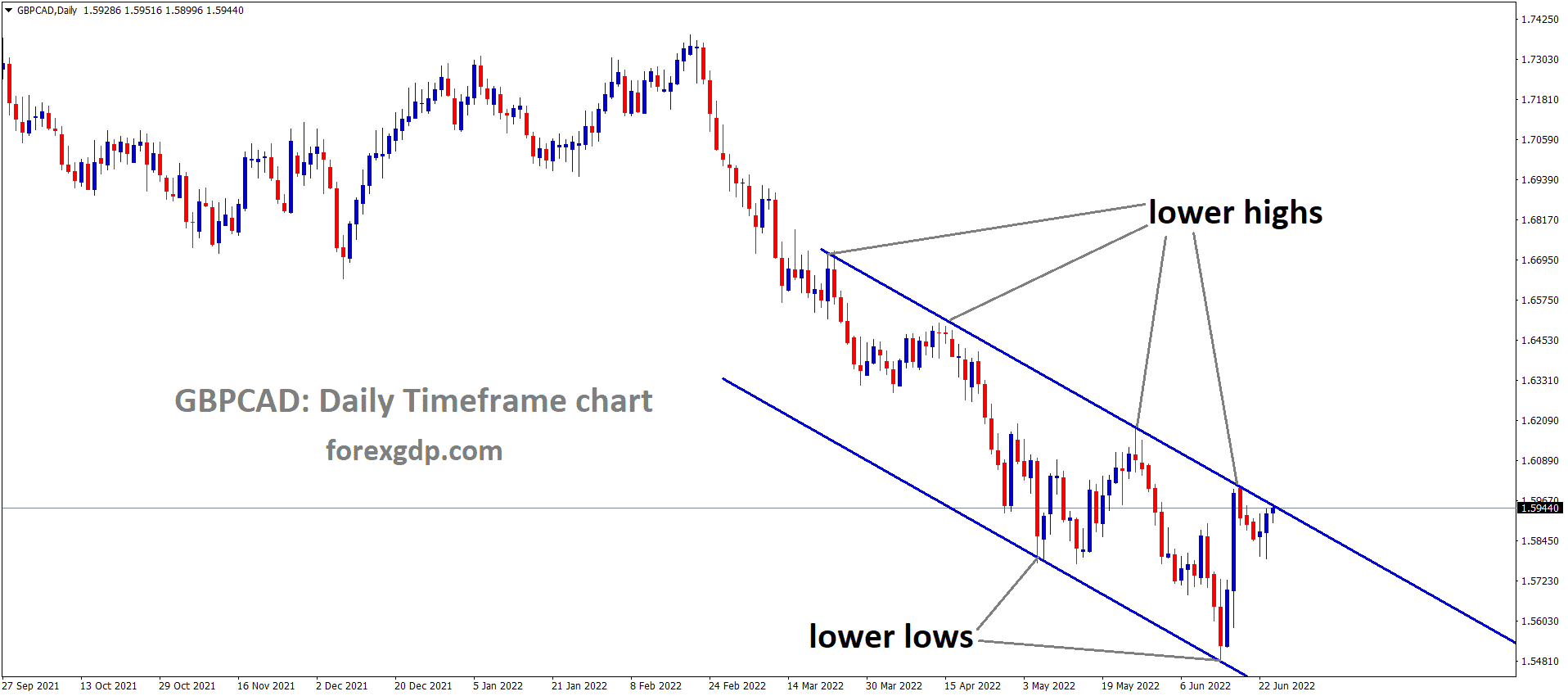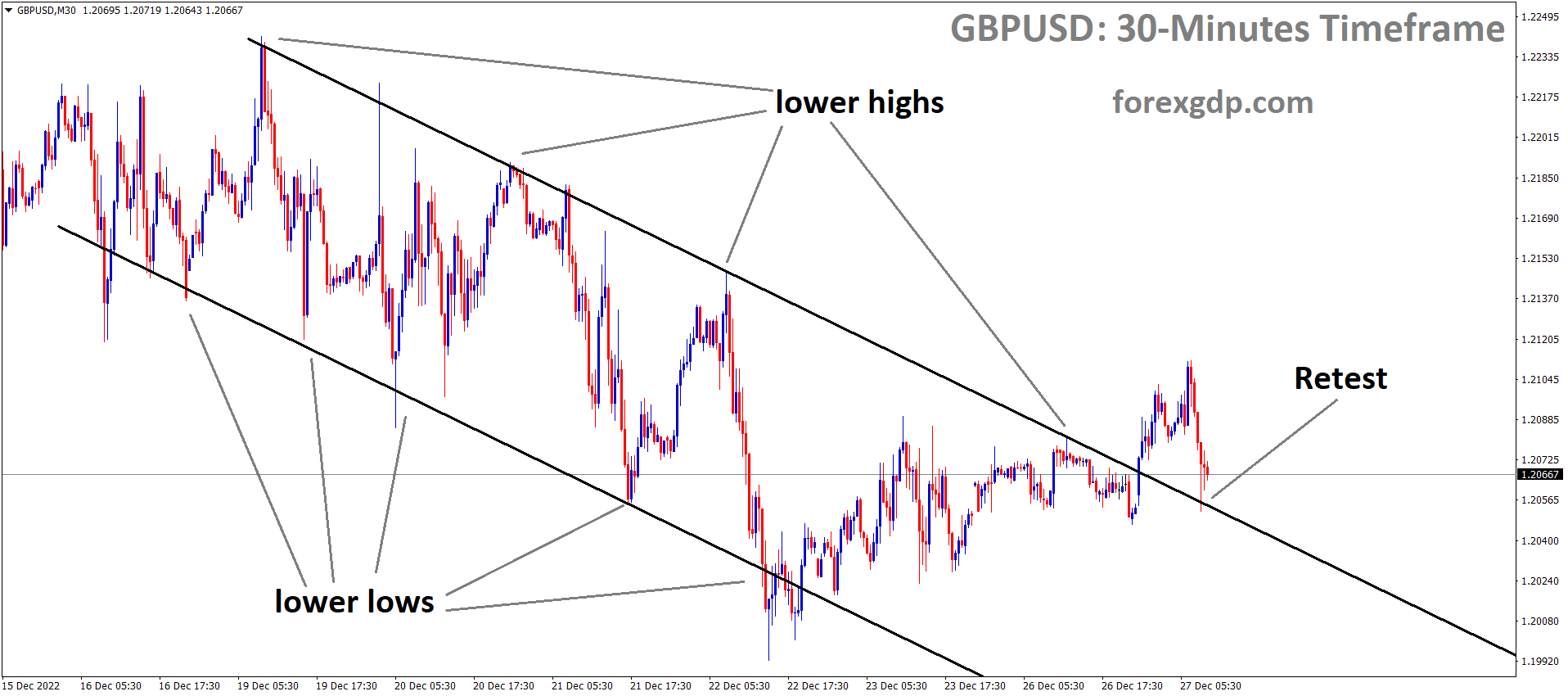XAUUSD – Gold Falls as US Dollar Rebounds Post Hot US Core PCE Inflation Data
The Gold prices are moved lower after the US PCE data came at higher than expected last day. Rate cuts in the September month expectations also diminished after the US GDP, Core PCE index came at higher than expected this week. On May 01, FED is expected to keep the rates at 5.25%-5.50% is possible due to strong domestic data reading prevailing in the market.
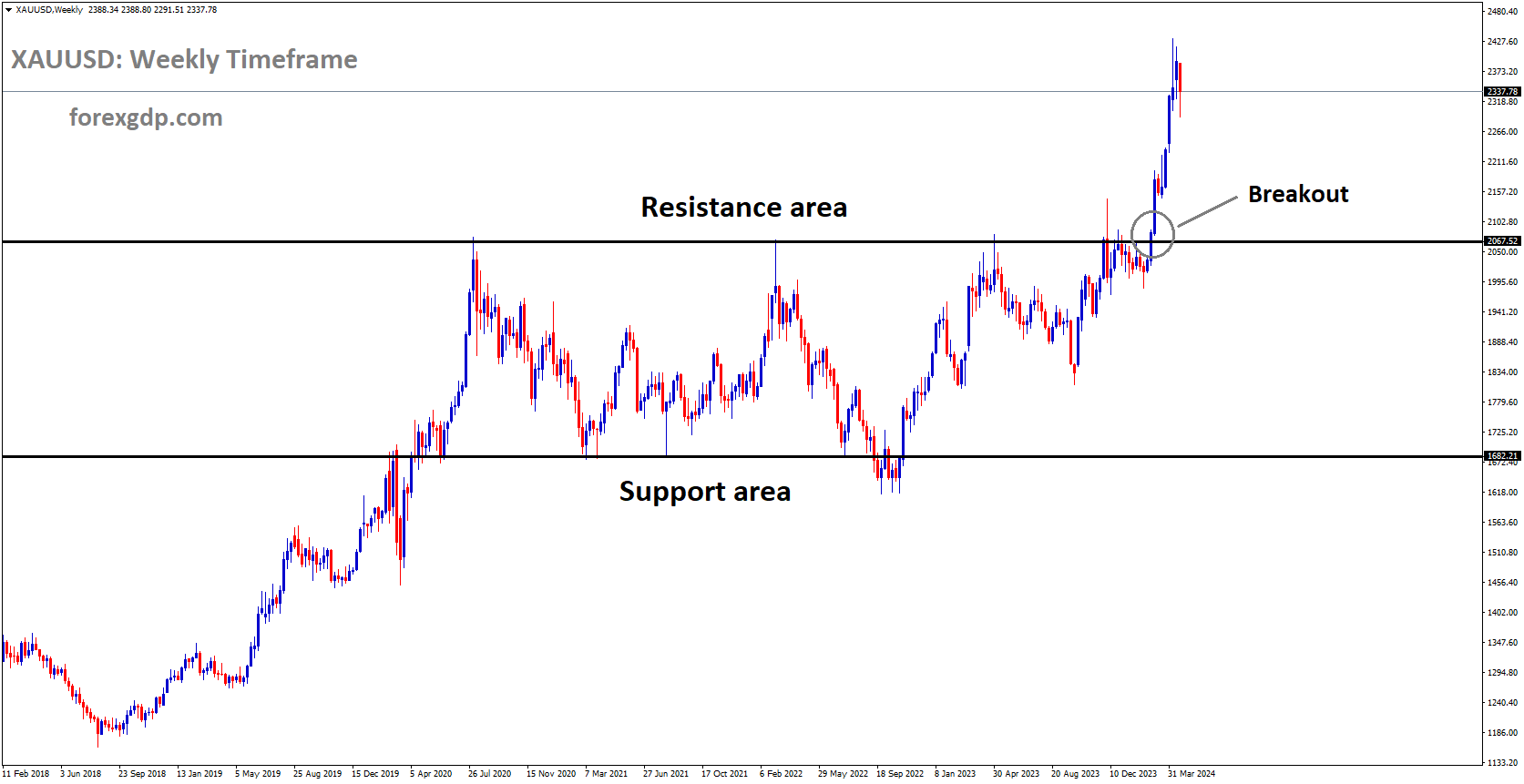
XAUUSD has broken box pattern in upside
The price of gold (XAU/USD) experienced a decline from $2,350 during Friday’s early New York session, driven by the release of higher-than-expected annual core Personal Consumption Expenditure Price Index (PCE) data for March in the United States. The annual underlying inflation rate rose more than anticipated, reaching 2.7% compared to the estimated 2.6%, although it slowed down from the 2.8% recorded in February.
The stronger-than-expected inflation figures diminished the appeal of gold, as they dampened hopes for potential rate cuts by the Federal Reserve (Fed) during the September monetary policy meeting. The monthly underlying inflation data, which grew in line with expectations and matched the previous reading of 0.3%, signaled positive prospects for bond yields and the US Dollar.
Despite a slight decrease to 4.69%, 10-year US bond yields remained near a five-month high. This resilience in yields was attributed to concerns that stagnant progress in inflation declining to the 2% target might prompt the Fed to postpone rate cuts until later this year.
Simultaneously, the US Dollar Index (DXY), tracking the Greenback’s value against six major currencies, rebounded to 105.80 following the release of the hotter-than-expected inflation data. The US Dollar had weakened on Thursday after disappointing US Q1 GDP growth figures raised doubts about the economy’s future strength.

In the daily market overview, gold struggled to maintain its position near $2,350 as the US Dollar regained strength post the release of the US core PCE inflation data for March. The weaker-than-expected US economic growth rate for Q1 contributed to concerns over the US economic outlook. Traders adjusted their expectations for Fed rate cuts due to persistent higher GDP Price Index and core PCE Price Index data.
Looking ahead, investors are attentive to the US core PCE Price Index data for March, seeking further insights into the Fed’s potential interest rate adjustments. This underlying inflation data is expected to influence the Fed’s interest rate outlook ahead of the upcoming monetary policy meeting on May 1, where the central bank is widely anticipated to maintain interest rates unchanged within the range of 5.25%-5.50%.
EURUSD – Falls Post PCE Data Beat Delay
The EURUSD plunged down after the US Core PCE index came at higher than expected. Coming weeks Euro zone Q1 GDP and German Q1 GDP data is scheduled, Euro CPI for month of March is scheduled, ECB Policy makers expected June month rate cut due to economy slowdown in the Eurozone compared to the US.
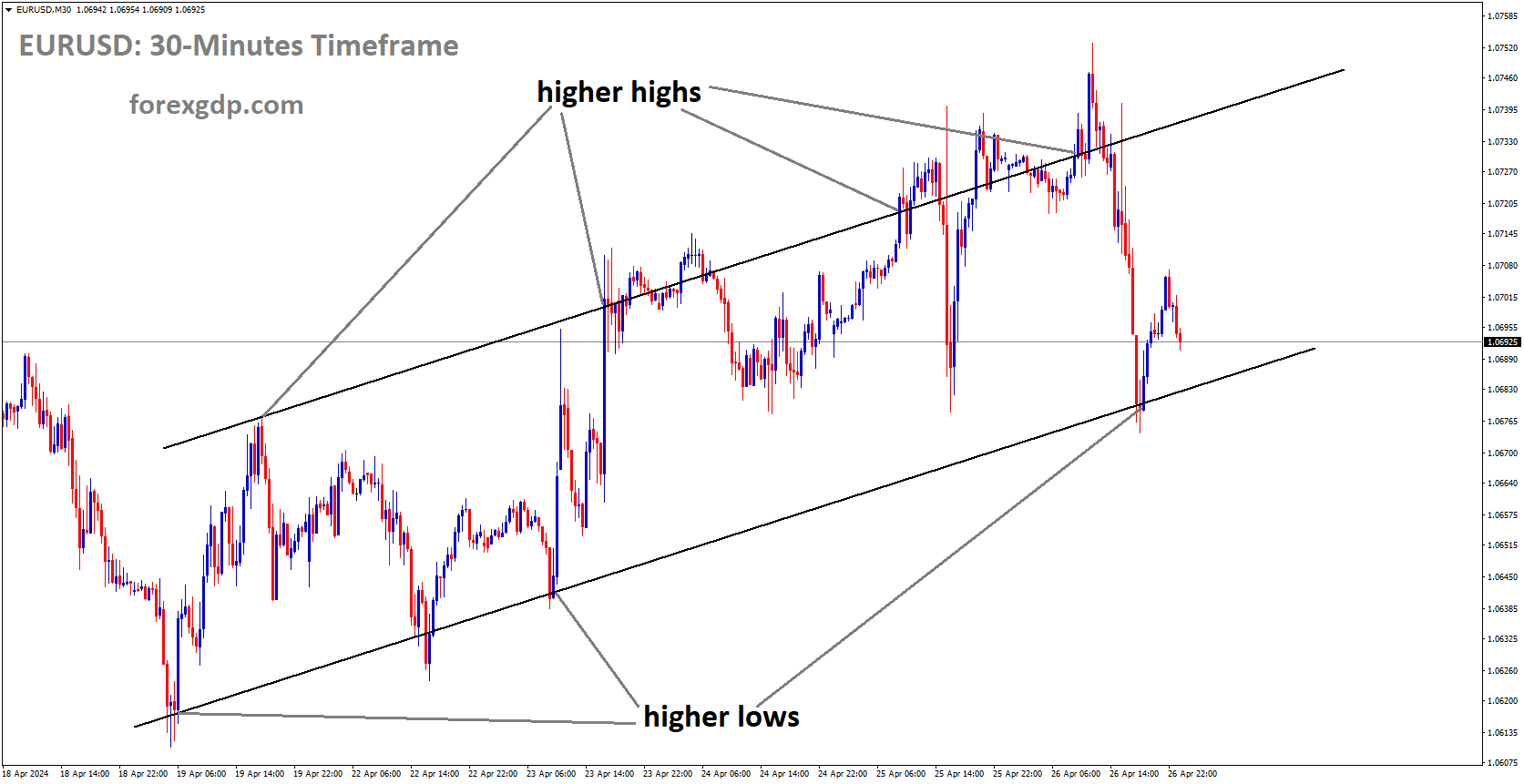
EURUSD is moving in Ascending channel and market has rebounded from the higher low area of the channel
On Friday, EUR/USD retreated below the 1.0700 level as traders assessed the ramifications of the March core Personal Consumption Expenditures Price Index (PCE), which serves as the preferred gauge of inflation for the US Federal Reserve (Fed).
Initially, the currency pair surged following the release of the report. However, it swiftly reversed course, plunging below the critical 1.0700 threshold after the core PCE data revealed a higher-than-anticipated year-over-year reading of 2.8%, surpassing analysts’ expectations of 2.6% and slightly down from the previous 2.8%, according to data from the US Bureau of Economic Analysis (BEA). On a monthly basis, Core PCE increased by 0.3%, aligning with expectations and unchanged from the previous reading.
In the aftermath of the release, the probability of the Federal Reserve implementing an interest-rate cut in September edged up from 59% prior to the event to 60%.
Additional figures from the PCE report indicated that the headline Personal Consumption Expenditures Price Index climbed to 2.7%, surpassing estimates of 2.6% and the previous reading of 2.5%. Monthly PCE rose by 0.3%, meeting expectations and consistent with the previous figure. Personal Income also rose by 0.5%, in line with forecasts, while Personal Spending increased by 0.8%, surpassing estimates of 0.6% and matching the previous reading.

In a separate development, EUR/USD experienced a significant decline to a low of 1.0678 on Thursday following the release of US first-quarter GDP data. Although the annualized GDP growth fell short of consensus expectations and decreased compared to the previous quarter, the robust performance of the Personal Consumption Expenditures Prices component, indicating a significant change in goods prices, bolstered the US Dollar (USD).
This inflationary data led market participants to revise down their expectations of when the Federal Reserve (Fed) might commence interest rate cuts. Analysts at Deutsche Bank noted that the likelihood of a rate cut by the July meeting decreased from 50% the previous day to 34% thereafter.
The anticipation of prolonged higher interest rates temporarily bolstered the Greenback and weighed on EUR/USD, as elevated interest rates tend to attract more foreign capital inflows.
USDCAD – CAD weakens vs. USD on US PCE miss
The Canadian Dollar moved down after the US PCE index inflation steady at 0.30% in the March month, Core PCE index rate rose to 2.8% versus 2.6% printed in the last month, PCE index rate rose to 2.7% from 2.6% in the last month. US Dollar dominated against Canadian Dollar yesterday, This week Canadian GDP data is scheduled, further directions will decided by the readings.
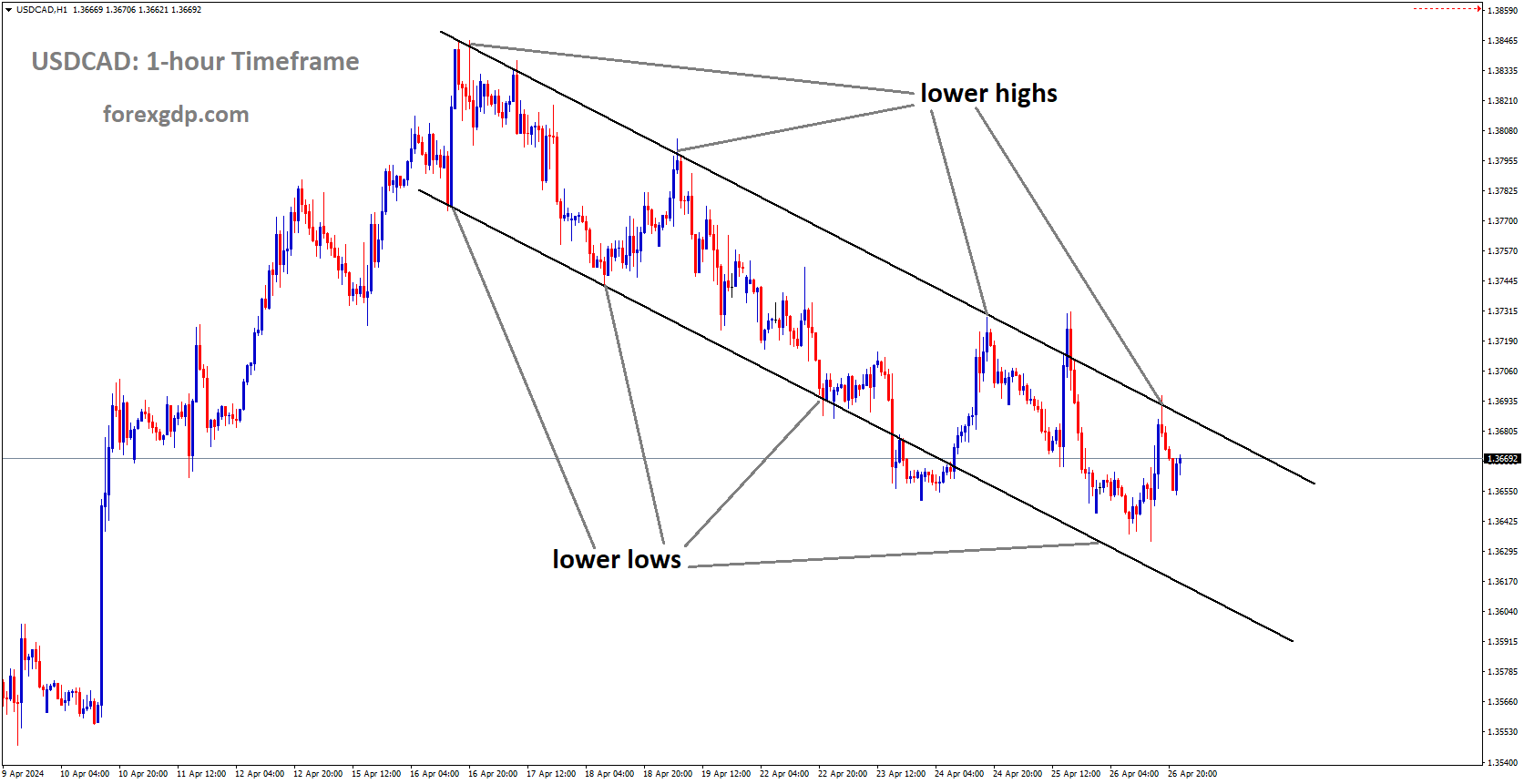
USDCAD is moving in Descending channel and market has fallen from the lower high area of the channel
On Friday, the Canadian Dollar (CAD) faced downward pressure amidst broader market dynamics, largely influenced by dwindling expectations of a rate cut by the Federal Reserve (Fed). This sentiment was exacerbated by the release of US Personal Consumption Expenditure (PCE) Price Index figures, which surpassed forecasts, further dampening expectations of rate cuts.
Canada’s economic calendar remains relatively quiet until next Tuesday’s release of the Gross Domestic Product (GDP) figures. However, market attention is primarily fixed on the upcoming Fed rate decision scheduled for the following Wednesday. Additionally, investors are preparing for another Nonfarm Payrolls (NFP) report next week, seeking clues about a potential slowdown in the US economy that could prompt rate adjustments.

In a nutshell, the daily market highlights include the persistence of elevated US PCE inflation levels. The core US PCE Price Index for March met expectations at a steady 0.3%. Meanwhile, the year-over-year Core PCE Price Index remained unchanged at 2.8%, surpassing the anticipated 2.6%. Moreover, the annualized headline PCE Price Index for the year ended March exceeded expectations at 2.7%, accelerating from the previous 2.5%. These inflationary trends are contributing to diminishing hopes of a September rate cut, as reflected by the CME’s FedWatch Tool, which indicates only a 60% probability of such an event.
USDCHF – SNB’s Jordan: Close Inflation Monitoring, Policy Adjustments Ahead
The SNB Chairman Thomas Jordan said rate cuts in the March month is correct for economy resilience in the Swiss economy with quite inflation. Anytime shocking will happened in the world, we have to adjust according to that scenario. So inflation keep lower we do rate cuts further in the economy is possible.
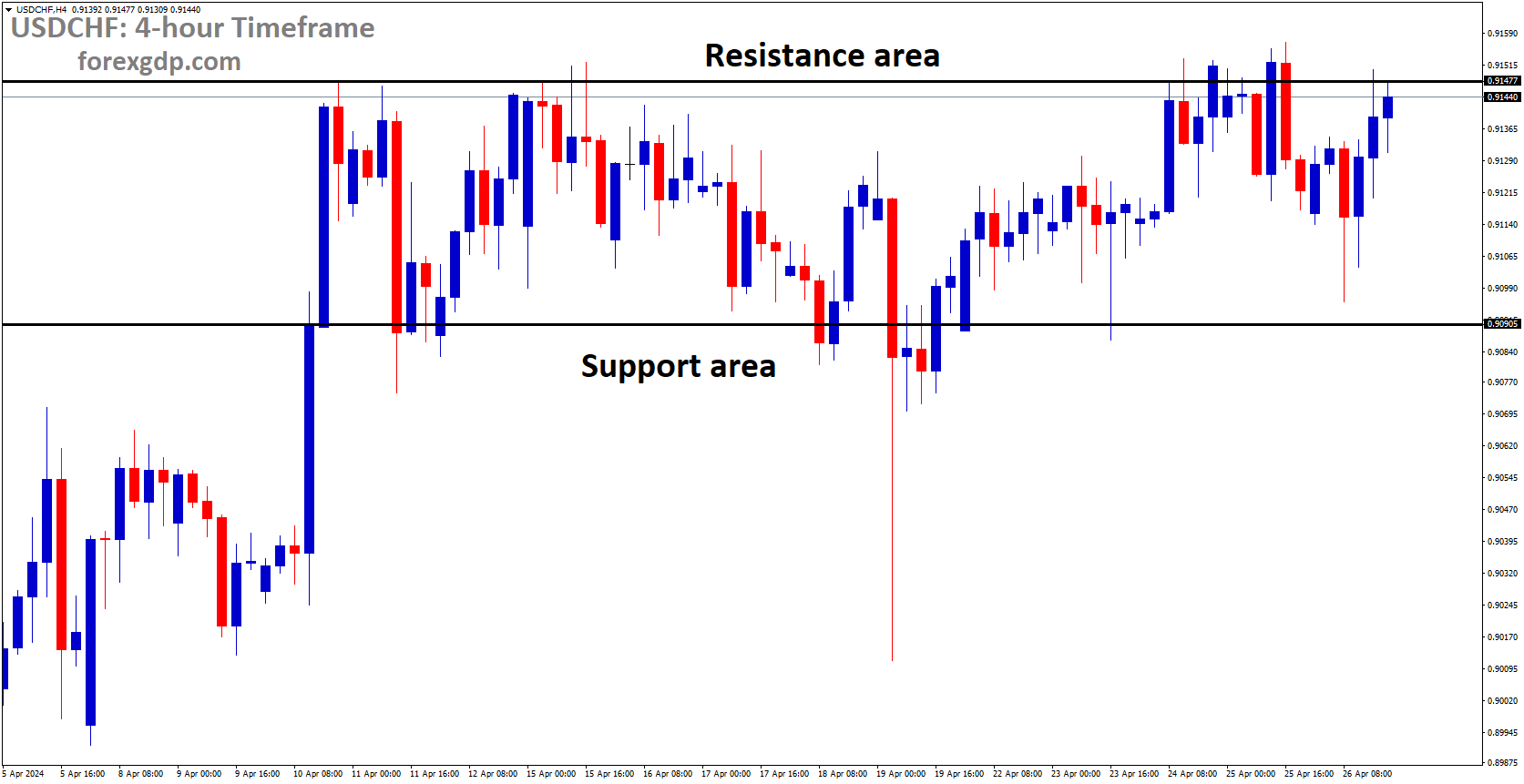
USDCHF is moving in box pattern and market has reached resistance area of the pattern
Swiss National Bank (SNB) Chairman Thomas J. Jordan addressed shareholders at the SNB’s General Meeting on Friday, emphasizing the bank’s commitment to closely monitoring inflation. He assured that the SNB stands ready to “adjust policy again when necessary.” This statement comes in the wake of the SNB’s unexpected decision in March to reduce its main policy rate by 0.25 percentage points to 1.5%.

In his remarks, Jordan highlighted the SNB’s success in combating inflation but cautioned that uncertainty remains high, and unforeseen shocks could occur at any time. He stressed the importance of maintaining focus on price stability, despite external pressures or criticisms.
Additionally, Jordan warned against calls to broaden the SNB’s mandate, deeming such demands as perilous. He asserted that maintaining a clear focus on the SNB’s core objectives is essential for ensuring effective monetary policy.
USD INDEX – USD Peaks After PCE Data
The US Dollar moved higher against counter pairs after the US Core PCE index reading came at higher than expected last day, US Q1 GDP printed at lower than expected on Thursday but came at positive reading in the January- March quarter. Coming week FED is expected to keep the rates at hold makes US Dollar supportive higher against counter pairs.Policy divergence from FED to other central banks keep USD supportive.
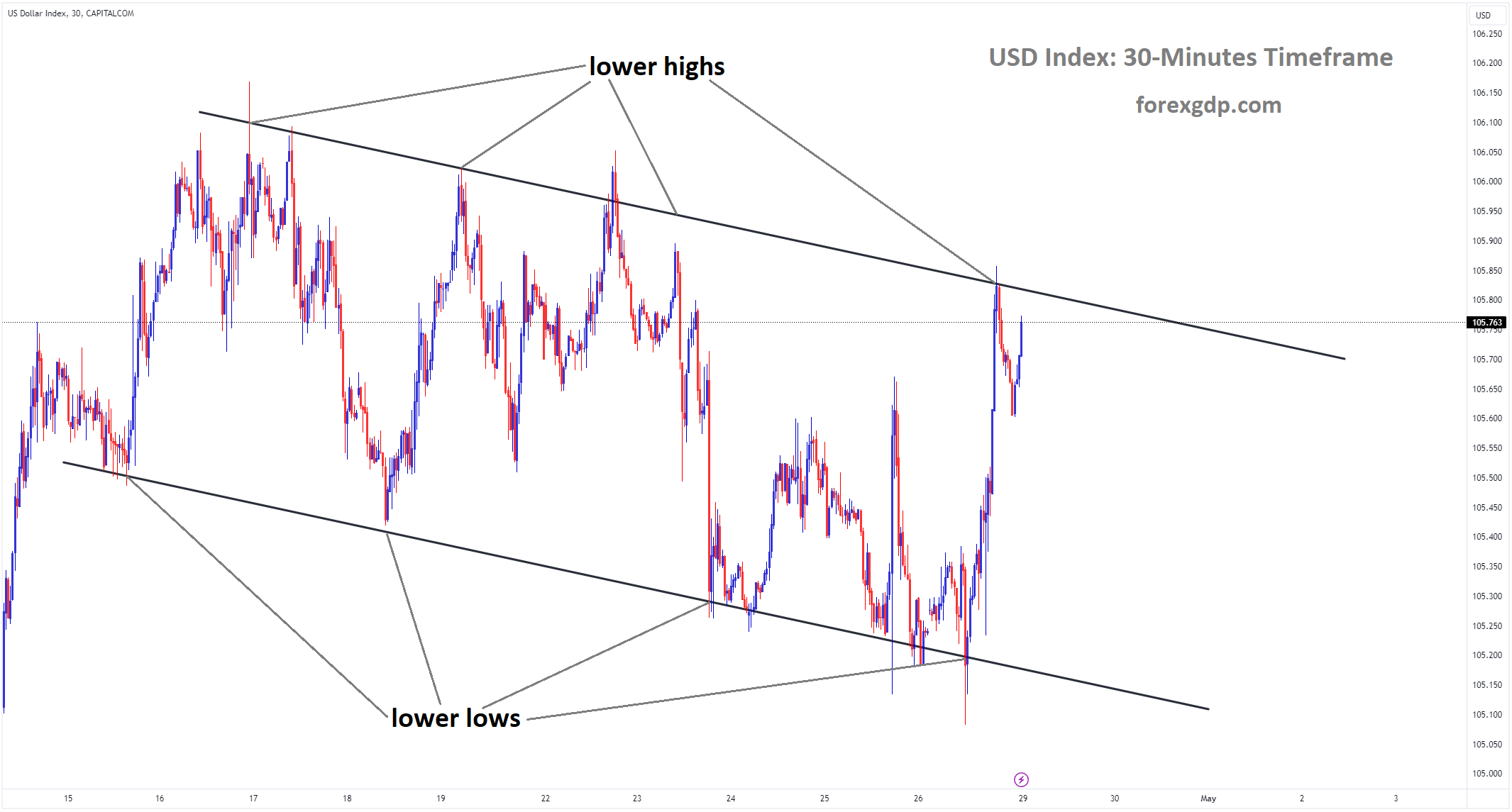
USD Index is moving in Descending channel and market has reached lower high area of the channel
The US Dollar (USD) is exhibiting strength as it heads towards the conclusion of this week’s economic data, following a tumultuous session on Thursday spurred by the release of the preliminary US Gross Domestic Product (GDP) figures for the first quarter. Initially, the USD surged in response to robust Personal Consumption Expenditure (PCE) numbers from the GDP release, leading to speculation that initial interest rate cuts might be delayed further, briefly overshadowing expectations for rate cuts in September with December becoming a possibility. However, as the market absorbed all the data, it interpreted the scenario as indicative of stagflationary conditions, resulting in a surge in equities and exerting downward pressure on the USD, as the likelihood of rate cuts in 2024 remained on the table, dispelling earlier rumors of a potential rate hike.
Turning to economic indicators, the US Federal Reserve’s preferred inflation measure, the Personal Consumption Expenditure (PCE) Price Index, was released. While the PCE figures didn’t reveal any significant surprises, the data on Personal Income and Spending indicated ongoing consumer spending, suggesting that inflationary pressures are persisting, reinforcing the expectation of a prolonged steady rate trajectory that could bolster the USD.
In the daily market overview:
– Overnight, the Bank of Japan (BoJ) maintained its interest rates, causing USD/JPY to reach 156.80.
– A volatile episode occurred in the USD/JPY pair during European trading hours, with the pair briefly dipping to 155.00 before recovering to 156.75, prompting speculation about potential intervention by the Japanese Ministry of Finance or the Bank of Japan.

– At 12:30 GMT, March’s Personal Consumption Expenditures (PCE) data was released, showing stable monthly headline and core PCE figures, with a rise in yearly headline PCE to 2.7% and steady yearly core PCE at 2.8%. Personal Income for the month increased to 0.5%, while Personal Spending remained unchanged at 0.8%.
– At 14:00 GMT, the University of Michigan’s final data for April was released, indicating a decline in Consumer Sentiment from 77.9 to 77.2, while five-year consumer inflation expectations remained steady at 3%.
– Equities worldwide are experiencing gains following the Bank of Japan’s rate decision, with major indices in Asia, Europe, and US futures all trading positively.
– The CME Fedwatch Tool suggests an 88.5% probability of no change to the Federal Reserve’s feds fund rate in June, with the possibility of a rate cut in July ruled out, while for September, there’s a 44.6% chance of rates being lower than current levels.
– The benchmark 10-year US Treasury Note continues to hover around 4.68%.
Overall, the USD’s strength is underscored by the ongoing economic data and market sentiment, positioning it for further developments in the near term.
GBPJPY – Hits 197.00 Level First Time Since 2008
The GBPJPY surged above 197.00 level as 2008 mark, BoJ ultra loose easy monetary policy settings and continuous purchasing of JGB bonds from BoJ in the upcoming months makes JPY weaker against GBP.Coming week Japan retail sales for the March month is expected to ease down as 2.2% from 4.6% printed in the last month. Overall Negative outlook surrounding JPY against counter pairs.
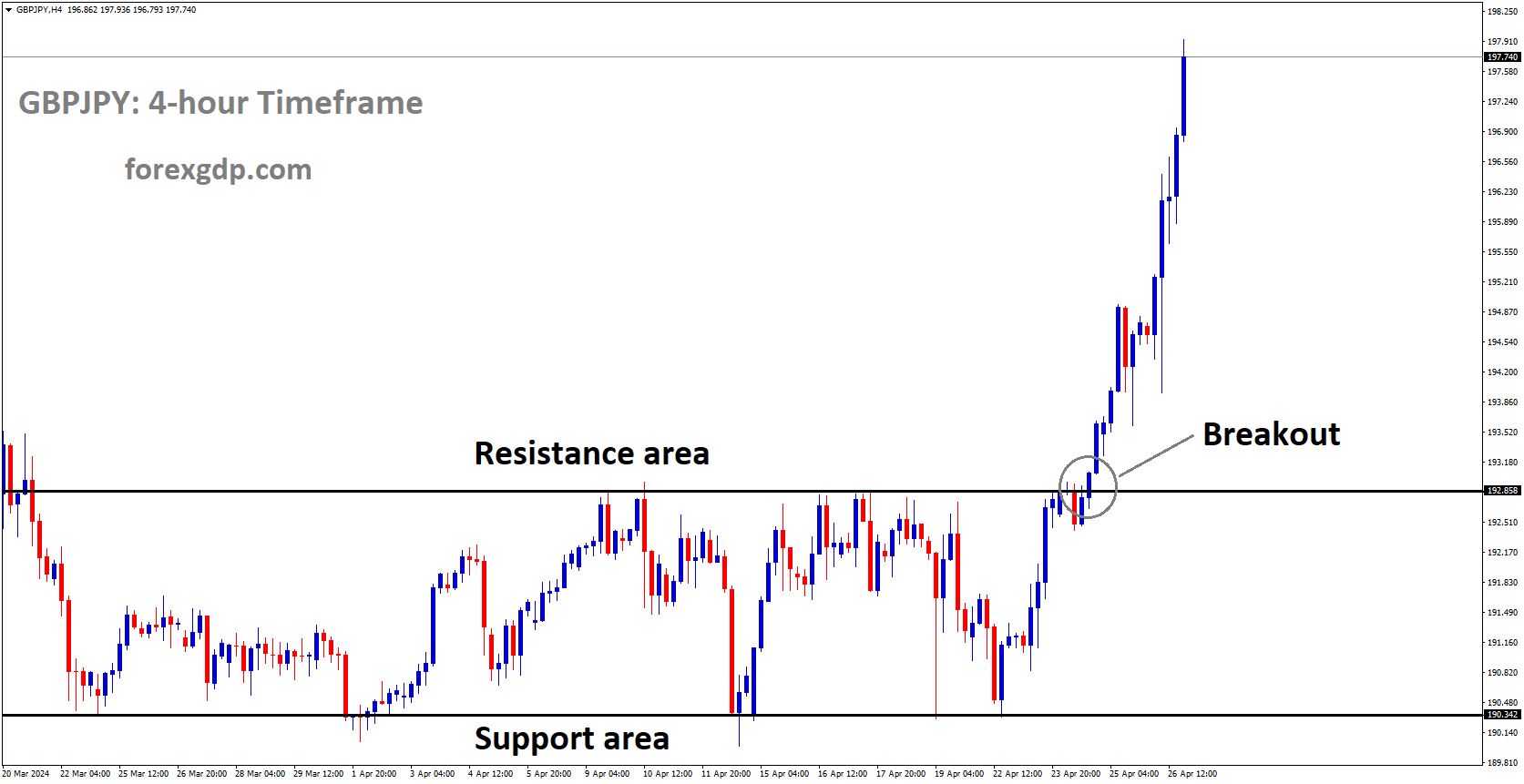
GBPJPY has broken box pattern in upside
GBP/JPY surged above the 197.00 level on the charts, marking its highest point since September 2008. This milestone occurred amidst intense market pressure on the Bank of Japan (BoJ), resulting in a prolonged weakening of the Japanese Yen to lows not seen in decades.
The BoJ opted to maintain its aggressive monetary policy stance, triggering a widespread sell-off of the Yen across various markets. In its efforts to stimulate the economy, the central bank announced plans to resume large-scale purchases of Japanese government bonds. However, BoJ Governor Kazuo Ueda’s remarks on Yen exchange rates, inflation, and interest rate guidance were perceived as inadequate, leading to disappointment among market participants.

Looking ahead to the upcoming week, the economic calendar for the UK appears relatively light. Meanwhile, investors await the release of Japan’s Retail Sales figures early on Tuesday. Projections suggest a moderation in Retail Trade growth to 2.2% for the year ending in March, down from the previous period’s 4.6%.
GBPUSD – GBP Falls as USD Rebounds on Hot US Core PCE Inflation
The BoE Governor Andrew Bailey said there are 3 more rate cuts in this year and inflation is slowdown in the economy as expected. Services inflation are higher at 6%, this will grow the employment pressure up and more wage hikes will be grow, then inflation will be higher. So 2% of BoE target is not possible in this year as per economists view. Higher inflation, lower rate makes Britain economy to stumble once again.
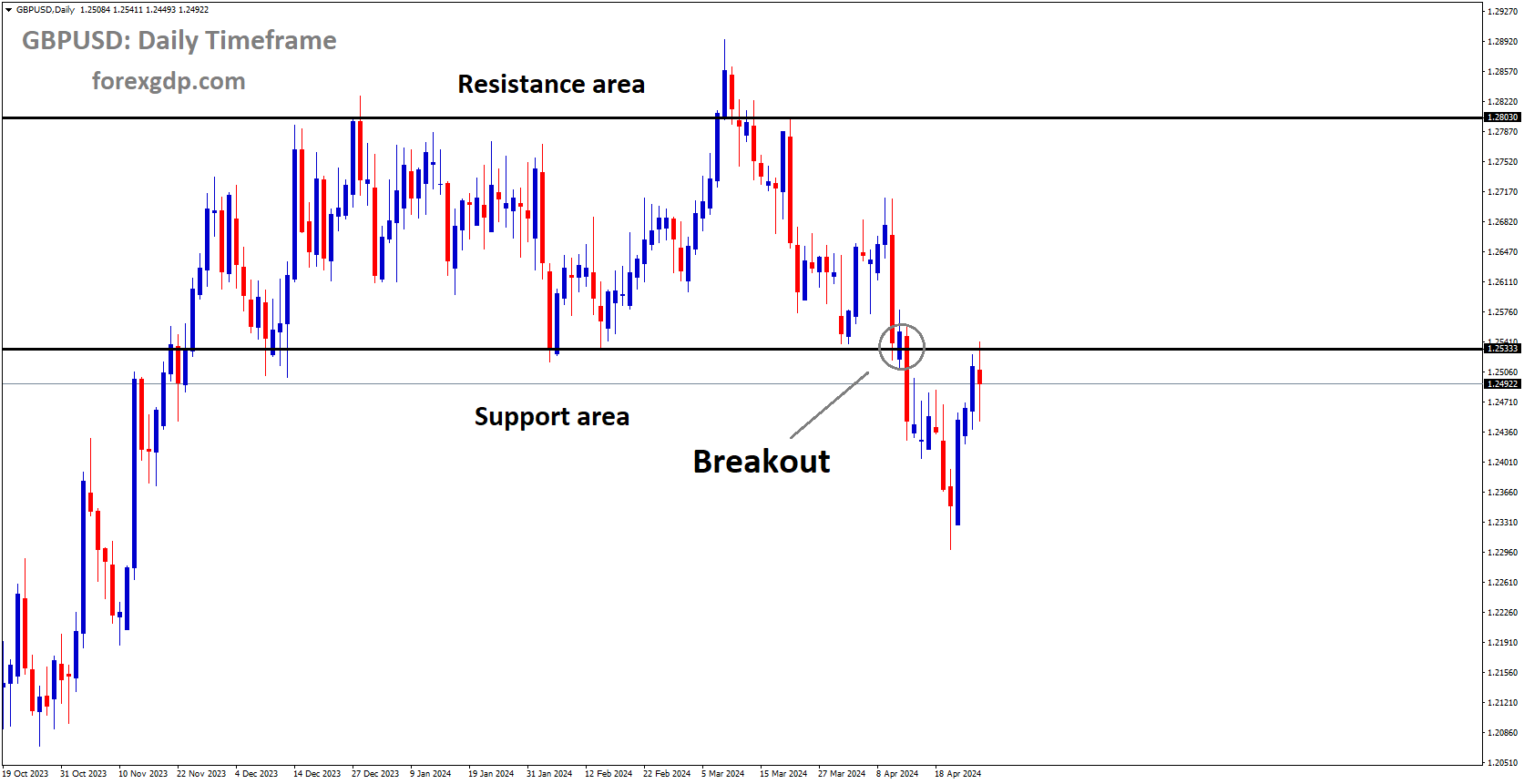
GBPUSD has broken box pattern in downside
In the early American session on Friday, the Pound Sterling (GBP) encountered selling pressure near the 1.2500 level against the US Dollar (USD). This decline in the GBP/USD pair reflects growing expectations that the Bank of England (BoE) will initiate interest rate reductions starting from the June meeting. While BoE policymakers anticipate a significant decline in inflation in the coming months, they have refrained from specifying a definitive timeline for interest rate cuts. During the press conference following the recent monetary policy meeting, BoE Governor Andrew Bailey acknowledged that market expectations for two or three rate cuts this year are not unreasonable.
Despite the BoE’s maintenance of higher interest rates, the economic outlook for the United Kingdom has shown improvement. The preliminary Purchasing Managers’ Index (PMI) report from S&P Global/CIPS for April, released earlier in the week, revealed robust activity in the services sector, contributing to overall economic activity despite a lagging Manufacturing PMI. Moreover, the data indicated strong inflows of new business in the service sector.
Increased demand for services typically leads to growth in employment and wages within the sector, thereby exerting upward pressure on inflation. This could impede progress towards achieving the desired inflation rate of 2%. Additionally, BoE policymakers have expressed concerns about elevated service inflation, which currently stands at 6%, exceeding the level required for aligning inflation with the 2% target.

In the broader market context:
– The Pound Sterling struggles to maintain its strength near a ten-day high around the psychological level of 1.2500 against the US Dollar, as the US Dollar rebounds following hotter-than-expected US core Personal Consumption Expenditures Price Index (PCE) data for March.
– Annually, underlying inflation grew at a faster pace of 2.7%, surpassing estimates of 2.6% but lower than the previous reading of 2.6%. On a monthly basis, inflation rose steadily by 0.3%.
– The persistence of stubborn inflation data could allow the Federal Reserve to maintain a hawkish rhetoric, with policymakers emphasizing that interest rate cuts will only be considered when there is confidence in a sustainable return of inflation to the 2% target.
– Investors are eagerly awaiting the Fed’s monetary policy decision, scheduled for Wednesday. The Fed is widely expected to maintain interest rates unchanged within the range of 5.25%-5.50%. Market participants will closely scrutinize the Fed’s guidance for interest rates.
– On Thursday, the US Dollar faced pressure following the release of the preliminary Gross Domestic Product (GDP) growth data for the first quarter, which fell below expectations. The economy expanded at a slower pace of 1.6% in Q1, below expectations of 2.5% and the previous reading of 3.4%. Despite the data miss, traders maintain strong expectations for the Federal Reserve to commence interest rate reductions from September or the fourth quarter, particularly given the significant increase in the GDP Price Index, which rose to 3.1% from the previous reading of 1.7%.
AUDUSD – Extends Gains on Fifth Consecutive Up-Day Post US Core PCE Beat
The Australian Factory gate price inflation rose to 4.3% in Q1 from 4.1% in the previous quarter. Australian PPI data also came at higher than expected last day makes Australian Dollar moved higher against counter pairs. RBA is expected to cut the rates at February 2025 is possible due to CPI Data printing is higher than expected levels.
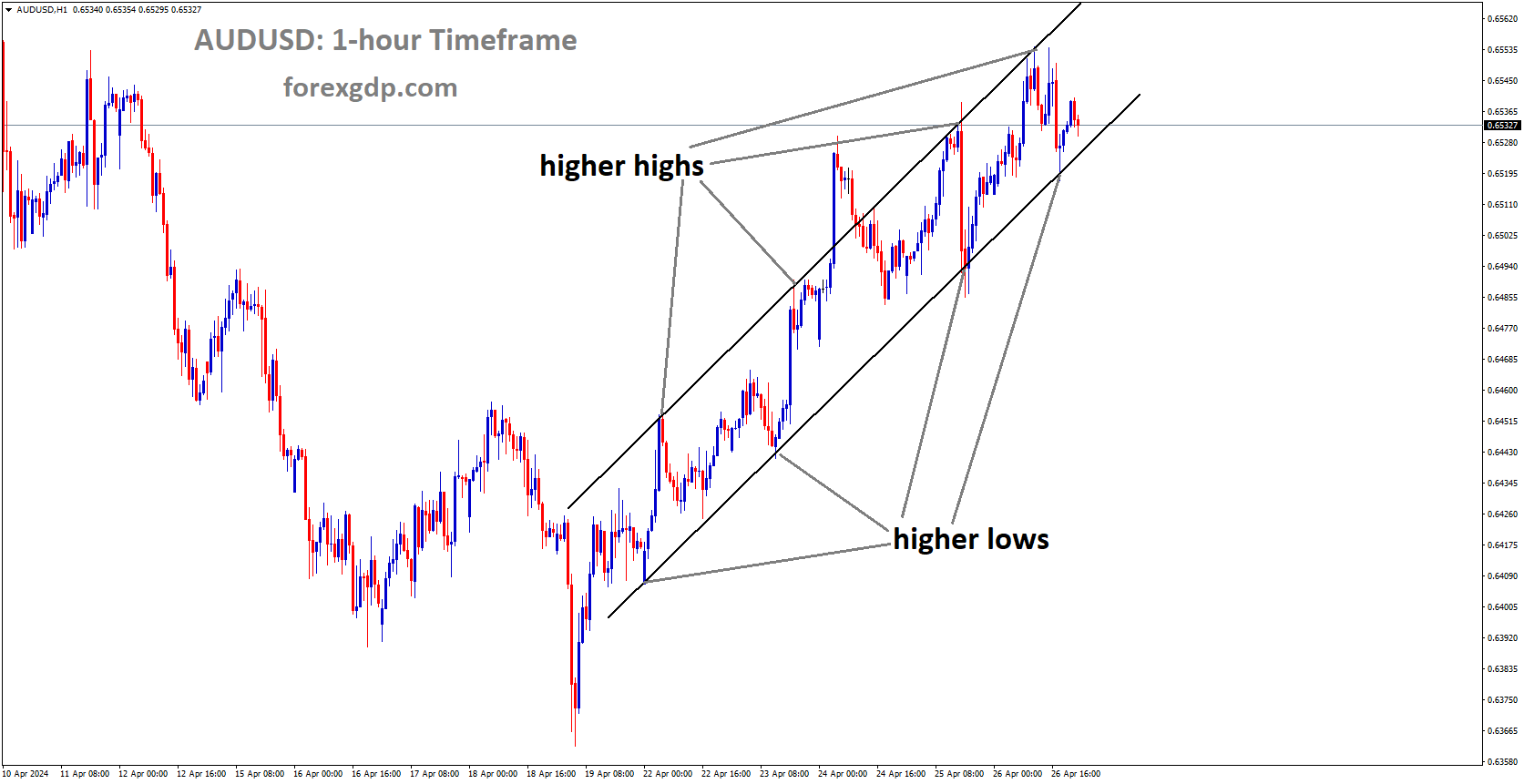
AUDUSD is moving in Ascending channel and market has reached higher low area of the channel
AUD/USD is currently trading in the 0.6540s, maintaining its upward momentum following the release of US core Personal Consumption Expenditures Price (PCE) Index data for March. Despite the data indicating a higher-than-expected inflation rate, the US Dollar (USD) has exhibited minimal reaction across most pairs, including AUD/USD. If Friday concludes with a bullish close, it would mark the fifth consecutive daily gain for AUD/USD.
In March, the US core PCE registered a year-over-year increase of 2.8%, surpassing both the expected 2.6% and the previous reading of 2.8%. Meanwhile, the headline PCE rose by 2.7%, exceeding the anticipated 2.6% and the previous 2.5%. On a monthly basis, the PCE data aligned with expectations.
The subdued response of the US Dollar could be attributed to its anticipation of inflationary GDP data for the first quarter, released on Thursday, which had already factored in the inflationary core PCE figures.

Although the rate of US GDP growth decelerated in Q1, the GDP Price Index component, measuring goods inflation, experienced a significant increase compared to previous readings. Consequently, the US Dollar strengthened across most pairs, prompting AUD/USD to retreat to a low of 0.6486 after the data release.
Overnight, Australian factory price inflation data provided renewed momentum to the pair, revealing a 4.3% year-over-year increase in Q1, up from 4.1% in the previous quarter. Additionally, the Producer Price Index (PPI) data underscored growing price pressures in the Australian economy, following better-than-expected Q1 CPI data released on Thursday, which also boosted AUD/USD.
Persistent inflationary pressures suggest that the Reserve Bank of Australia (RBA) is likely to be the last among G10 central banks to consider interest rate cuts. Some analysts are now delaying predictions for an RBA rate cut until February 2025. The expectation of a slower decline in Australian interest rates compared to other countries is supportive for the Australian Dollar (AUD), as relatively higher interest rates tend to attract greater capital inflows.
NZDUSD – Holds Strong Near 0.5950 on Enhanced Risk Appetite
The ANZ Roy Morgan consumer confidence reading came at 82.1 in the April month from 86.4 printed in the last month, this is the lowest reading since 2008. Trade surplus data for NZ is higher, exports are at 10-month high and imports declined to 2%. Due to elevated rates, consumer spending, business are affected.
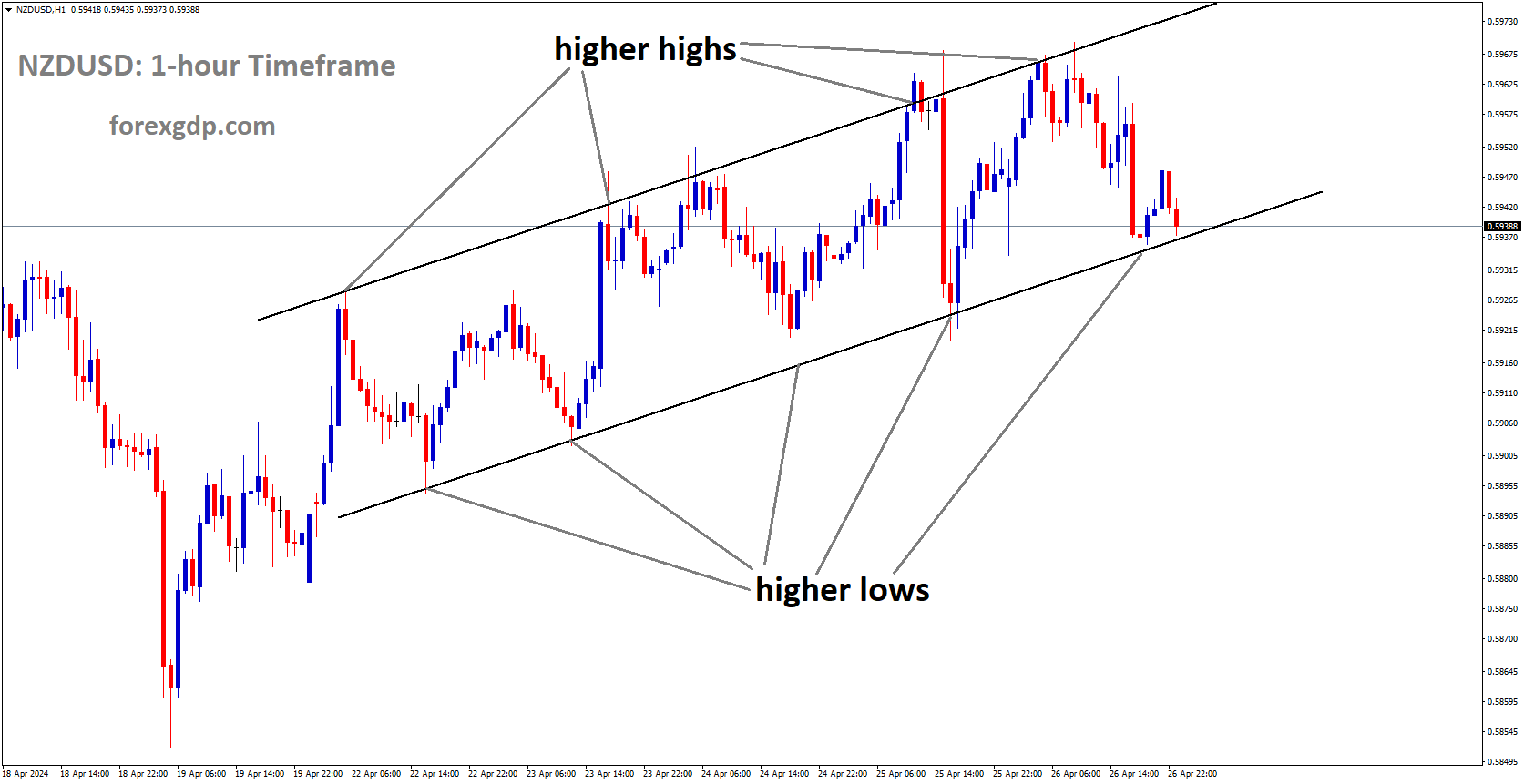
NZDUSD is moving in Ascending channel and market has reached higher low area of the channel
The New Zealand Dollar (NZD), renowned for its sensitivity to shifts in risk sentiment, gathered momentum as investor appetite for risk improved, bolstering the NZD/USD pair. However, the pair experienced a slight retracement of its intraday gains due to a resurgence in the US Dollar (USD).
Nevertheless, the USD’s upward momentum may be tempered by a corrective pullback in US Treasury yields, contributing to the overall weakness of the USD.
On Thursday, a mixed bag of preliminary data from the United States (US) exerted pressure on the Greenback. The US Gross Domestic Product Annualized (Q1) expanded at a slower pace of 1.6% compared to the previous reading of 3.4%, falling short of market expectations of 2.5%. This deceleration implies potential headwinds or slowdowns across various sectors of the economy.
However, US consumer prices demonstrated resilience, with the Personal Consumption Expenditures (QoQ) Price Index for Q1 registering a 3.7% annual increase. This surpassed both market forecasts of 3.4% and the previous reading of 2.0%, indicating persistent inflationary pressures that could influence Federal Reserve (Fed) monetary policy decisions.

On the New Zealand front, Friday’s ANZ-Roy Morgan Consumer Confidence dipped to 82.1 in April, down from the previous reading of 86.4, marking its lowest level since 2008. Despite this decline, consumer confidence in New Zealand remains relatively robust. Additionally, Stats NZ reported a trade surplus in March, driven by exports reaching a 10-month high while imports dwindled to a 2-month low. The decline in imports reflects a sluggish economy, as both households and businesses contend with the impact of elevated interest rates.
Looking ahead, market attention is squarely focused on the release of the US Personal Consumption Expenditures (PCE) Price Index data for March, scheduled for Friday. Investors are keenly awaiting this data release as they evaluate its implications for inflationary pressures and its potential impact on US monetary policy decisions.
CRUDE OIL – WTI Dips Near $83.50 on Weaker Demand Outlook Post US GDP
The Israel invasion of Southern city of Gaza, Rafah makes more civilians gets assaulted, despite warning from western countries, Israel doing massive human assault in the Rafah region, Israel announced to civilians to vacate from place, inorder to protect them from this war. This war makes Oil supply disruptions in the world market. So Oil prices makes volatility movements against USD.
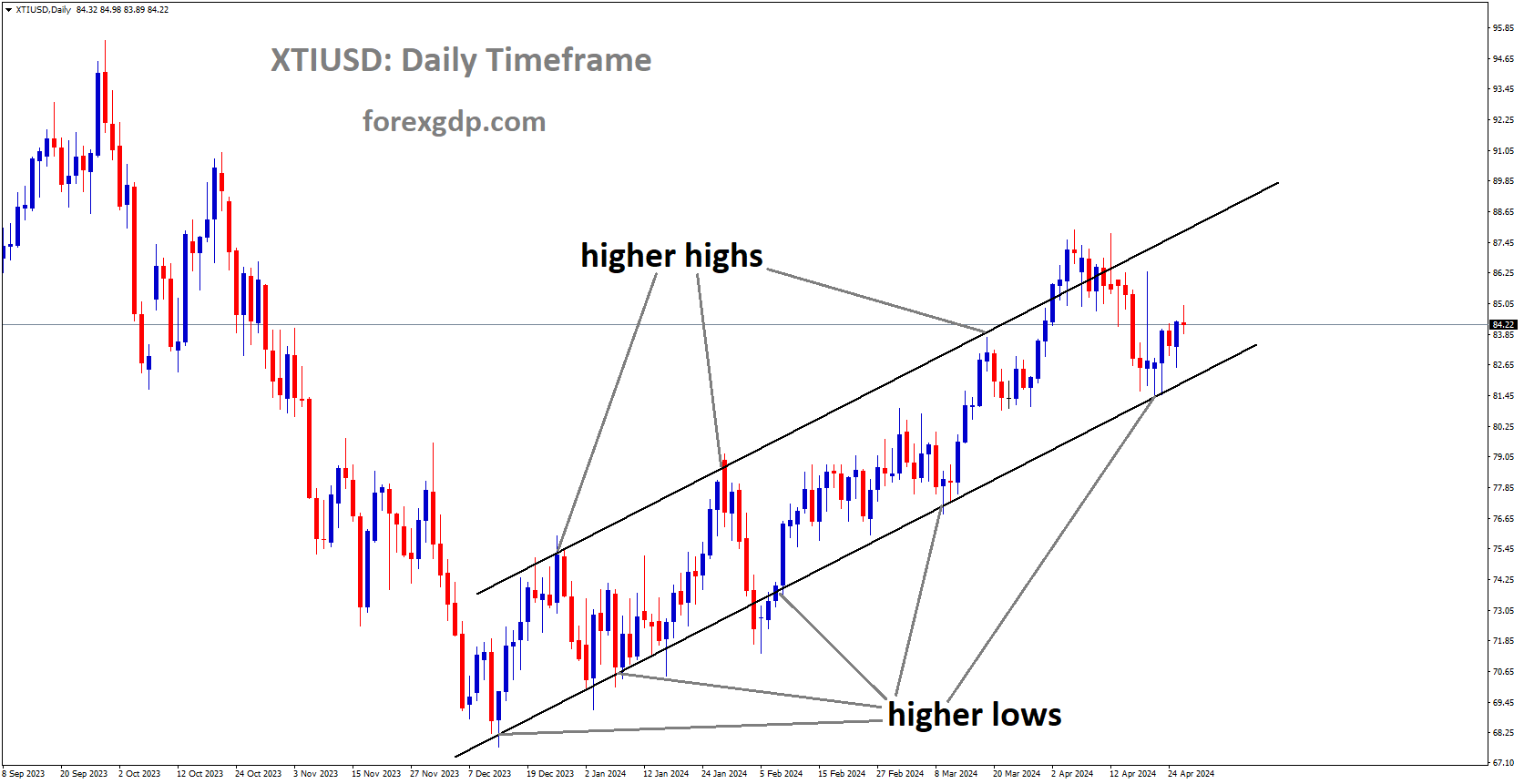
XTIUSD is moving in Ascending channel and market has rebounded from the higher low area of the channel
During European trading hours on Friday, the price of West Texas Intermediate (WTI) crude oil hovered near $83.40 per barrel, registering a slight decrease of 0.10%. This movement comes in response to the release of the US Gross Domestic Product Annualized (Q1) data, which revealed a slower expansion rate of 1.6% compared to the previous reading of 3.4%. The figure fell short of market expectations of 2.5%, indicating potential headwinds or slowdowns across various sectors of the US economy. This moderation in economic activity could potentially lead to reduced demand for oil.
Conversely, US consumer prices demonstrated resilience, with the Personal Consumption Expenditures (QoQ) Price Index for Q1 increasing at a robust 3.7% annual rate. This surpassed both market expectations of 3.4% and the previous reading of 2.0%.
The WTI oil price found support from comments made by US Treasury Secretary Janet Yellen during an interview with Reuters on Thursday. Yellen suggested that US GDP growth for the first quarter might be revised higher as additional data becomes available. Furthermore, she indicated that inflation is anticipated to revert to more normal levels after certain “peculiar” factors disrupt the economy.

Additionally, the price of oil received a boost from potential supply risks associated with the ongoing conflict in the Middle East, particularly concerns about a potential Israeli invasion of the southern Gaza city of Rafah.
Recent developments, as reported by Reuters, indicate escalated tensions in the region, with Israel escalating airstrikes on Rafah following its announcement of civilian evacuations from the southern Gazan city and plans for an all-out assault, despite warnings from allies about the potential for significant casualties. These geopolitical uncertainties contribute to the upward pressure on oil prices as market participants factor in potential disruptions to supply from the region.
Don’t trade all the time, trade forex only at the confirmed trade setups
Get more confirmed trade signals at premium or supreme – Click here to get more signals , 2200%, 800% growth in Real Live USD trading account of our users – click here to see , or If you want to get FREE Trial signals, You can Join FREE Signals Now!



